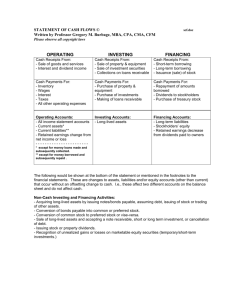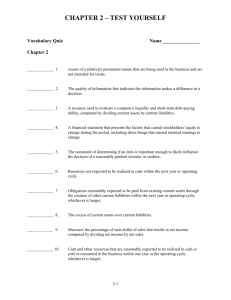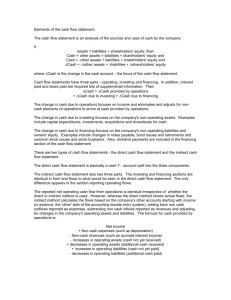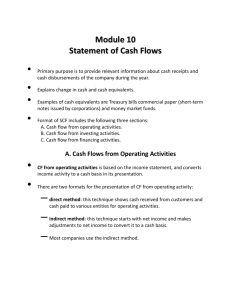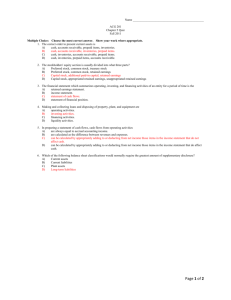TRUE FALSE—Conceptual 1. Liquidity refers to the ability of an
advertisement
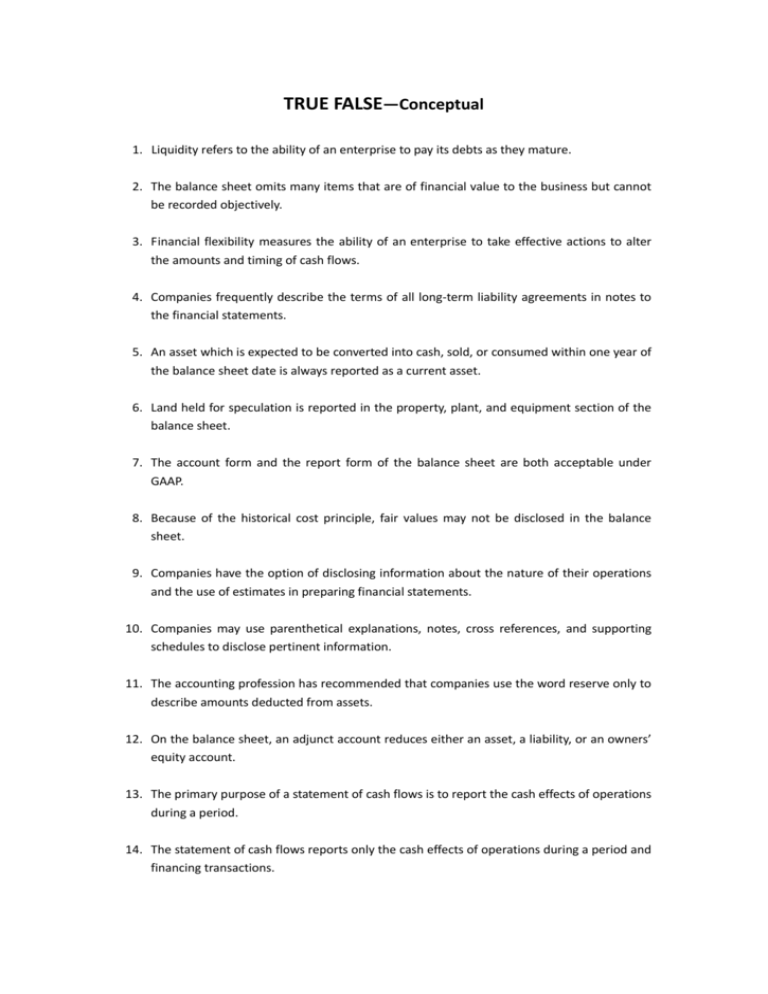
TRUE FALSE—Conceptual 1. Liquidity refers to the ability of an enterprise to pay its debts as they mature. 2. The balance sheet omits many items that are of financial value to the business but cannot be recorded objectively. 3. Financial flexibility measures the ability of an enterprise to take effective actions to alter the amounts and timing of cash flows. 4. Companies frequently describe the terms of all long-term liability agreements in notes to the financial statements. 5. An asset which is expected to be converted into cash, sold, or consumed within one year of the balance sheet date is always reported as a current asset. 6. Land held for speculation is reported in the property, plant, and equipment section of the balance sheet. 7. The account form and the report form of the balance sheet are both acceptable under GAAP. 8. Because of the historical cost principle, fair values may not be disclosed in the balance sheet. 9. Companies have the option of disclosing information about the nature of their operations and the use of estimates in preparing financial statements. 10. Companies may use parenthetical explanations, notes, cross references, and supporting schedules to disclose pertinent information. 11. The accounting profession has recommended that companies use the word reserve only to describe amounts deducted from assets. 12. On the balance sheet, an adjunct account reduces either an asset, a liability, or an owners’ equity account. 13. The primary purpose of a statement of cash flows is to report the cash effects of operations during a period. 14. The statement of cash flows reports only the cash effects of operations during a period and financing transactions. 15. Financial flexibility is a company’s ability to respond and adapt to financial adversity and unexpected needs and opportunities. 16. Collection of a loan is reported as an investing activity in the statement of cash flows. 17. Companies determine cash provided by operating activities by converting net income on an accrual basis to a cash basis. 18. Significant financing and investing activities that do not affect cash are not reported in the statement of cash flows or any other place. 19. Financial statement readers often assess liquidity by using the current cash debt coverage ratio. 20. Free cash flow is net income less capital expenditures and dividends. True False Answers—Conceptual Item Ans. Item Ans. Item Ans. Item Ans. 1. 2. 3. 4. 5. F T T T F 6. 7. 8. 9. 10. F T F F T 11. 12. 13. 14. 15. F F F F T 16. 17. 18. 19. 20. T T F T F MULTIPLE CHOICE—Conceptual 21. Which of the following is a limitation of the balance sheet? a. b. c. d. 22. Many items that are of financial value are omitted. Judgments and estimates are used. Current fair value is not reported. All of these The balance sheet is useful for analyzing all of the following except a. b. c. d. liquidity. solvency. profitability. financial flexibility. 23. Balance sheet information is useful for all of the following except to a. compute rates of return b. analyze cash inflows and outflows for the period c. evaluate capital structure d. assess future cash flows 24. Balance sheet information is useful for all of the following except a. assessing a company's risk b. evaluating a company's liquidity c. evaluating a company's financial flexibility d. determining free cash flows. S 25. A limitation of the balance sheet that is not also a limitation of the income statement is a. the use of judgments and estimates b. omitted items c. the numbers are affected by the accounting methods employed d. valuation of items at historical cost 26. The balance sheet contributes to financial reporting by providing a basis for all of the following except a. b. c. d. S27. One criticism not normally aimed at a balance sheet prepared using current accounting and reporting standards is a. b. c. d. P28. current assets minus current liabilities. total assets plus total liabilities. total assets minus total stockholders' equity. none of these. The correct order to present current assets is a. b. c. d. 31. solvency. financial flexibility. liquidity. exchangeability. The net assets of a business are equal to a. b. c. d. 30. failure to reflect current value information. the extensive use of separate classifications. an extensive use of estimates. failure to include items of financial value that cannot be recorded objectively. The amount of time that is expected to elapse until an asset is realized or otherwise converted into cash is referred to as a. b. c. d. 29. computing rates of return. evaluating the capital structure of the enterprise. determining the increase in cash due to operations. assessing the liquidity and financial flexibility of the enterprise. cash, accounts receivable, prepaid items, inventories. cash, accounts receivable, inventories, prepaid items. cash, inventories, accounts receivable, prepaid items. cash, inventories, prepaid items, accounts receivable. The basis for classifying assets as current or noncurrent is conversion to cash within a. the accounting cycle or one year, whichever is shorter. b. the operating cycle or one year, whichever is longer. c. the accounting cycle or one year, whichever is longer. d. the operating cycle or one year, whichever is shorter. 32. The basis for classifying assets as current or noncurrent is the period of time normally required by the accounting entity to convert cash invested in a. b. c. d. 33. The current assets section of the balance sheet should include a. b. c. d. 34. inventory back into cash, or 12 months, whichever is shorter. receivables back into cash, or 12 months, whichever is longer. tangible fixed assets back into cash, or 12 months, whichever is longer. inventory back into cash, or 12 months, whichever is longer. machinery. patents. goodwill. inventory. Which of the following is a current asset? a. Cash surrender value of a life insurance policy of which the company is the bene-ficiary. b. Investment in equity securities for the purpose of controlling the issuing company. c. Cash designated for the purchase of tangible fixed assets. d. Trade installment receivables normally collectible in 18 months. 35. Which of the following should not be considered as a current asset in the balance sheet? a. Installment notes receivable due over 18 months in accordance with normal trade practice. b. Prepaid taxes which cover assessments of the following operating cycle of the business. c. Equity or debt securities purchased with cash available for current operations. d. The cash surrender value of a life insurance policy carried by a corporation, the beneficiary, on its president. 36. Equity or debt securities held to finance future construction of additional plants should be classified on a balance sheet as a. b. c. d. 37. current assets. property, plant, and equipment. intangible assets. long-term investments. When a portion of inventories has been pledged as security on a loan, a. the value of the portion pledged should be subtracted from the debt. b. an equal amount of retained earnings should be appropriated. c. the fact should be disclosed but the amount of current assets should not be affected. d. the cost of the pledged inventories should be transferred from current assets to noncurrent assets. 38. Which of the following is not a long-term investment? a. b. c. d. 39. Cash surrender value of life insurance Franchise Land held for speculation A sinking fund A generally accepted method of valuation is 1. trading securities at market value. 2. accounts receivable at net realizable value. 3. inventories at current cost. a. b. c. d. 1 2 3 1 and 2 40. Which item below is not a current liability? a. b. c. d. 41. Working capital is a. b. c. d. 42. accrued interest on notes receivable. goodwill. goods in process. temporary investments. Long-term liabilities include a. b. c. d. 44. capital which has been reinvested in the business. unappropriated retained earnings. cash and receivables less current liabilities. none of these. An example of an item which is not an element of working capital is a. b. c. d. 43. Unearned revenue Stock dividends distributable The currently maturing portion of long-term debt Trade accounts payable obligations not expected to be liquidated within the operating cycle. obligations payable at some date beyond the operating cycle. deferred income taxes and most lease obligations. all of these. Which of the following should be excluded from long-term liabilities? a. Obligations payable at some date beyond the operating cycle b. Most pension obligations c. Long-term liabilities that mature within the operating cycle and will be paid from a sinking fund d. None of these 45. Treasury stock should be reported as a(n) a. b. c. d. 46. Which of the following should be reported for capital stock? a. b. c. d. 47. current asset. investment. other asset. reduction of stockholders' equity. The shares authorized The shares issued The shares outstanding All of these Which of the following would be classified in a different major section of a balance sheet from the others? a. b. c. d. Capital stock Common stock subscribed Stock dividend distributable Stock investment in affiliate 48. The stockholders' equity section is usually divided into what three parts? a. b. c. d. 49. Which of the following is not an acceptable major asset classification? a. b. c. d. P50. Current assets Long-term investments Property, plant, and equipment Deferred charges Which of the following is a contra account? a. b. c. d. S51. Preferred stock, common stock, treasury stock Preferred stock, common stock, retained earnings Capital stock, additional paid-in capital, retained earnings Capital stock, appropriated retained earnings, unappropriated retained earnings Premium on bonds payable Unearned revenue Patents Accumulated depreciation Which of the following balance sheet classifications would normally require the greatest amount of supplementary disclosure? a. b. c. d. Current assets Current liabilities Plant assets Long-term liabilities 52. The presentation of long-term liabilities in the balance sheet should disclose a. maturity dates. b. interest rates. c. conversion rights. d. All of the above. 53. Which of the following is not a required supplemental disclosure for the balance sheet? a. Contingencies b. Financial forecasts c. Accounting policies d. Contractual situations 54. Typical contractual situations that are disclosed in the notes to the balance sheet include all of the following except a. debt covenants b. lease obligations c. advertising contracts d. pension obligations 55. Accounting policies disclosed in the notes to the financial statements typically include all of the following except a. the cost flow assumption used b. the depreciation methods used c. significant estimates made d. significant inventory purchasing policies 56. Which of the following best exemplifies a contingency that is reported in the notes to the financial statements? a. Losses from potential future lawsuits b. Loss from a lawsuit settled out of court prior to the end of the fiscal year c. Warranty claims on future sales d. Estimated loss from an ongoing lawsuit 57. Which of the following is not a method of disclosing pertinent information? a. b. c. d. 58. Significant accounting policies may not be a. b. c. d. 59. Supporting schedules Parenthetical explanations Cross reference and contra items All of these are methods of disclosing pertinent information. selected on the basis of judgment. selected from existing acceptable alternatives. unusual or innovative in application. omitted from financial-statement disclosure. A general description of the depreciation methods applicable to major classes of depreci-able assets a. is not a current practice in financial reporting. b. is not essential to a fair presentation of financial position. c. is needed in financial reporting when company policy differs from income tax policy. d. should be included in corporate financial statements or notes thereto. 60. It is mandatory that the essential provisions of which of the following be clearly stated in the notes to the financial statements? a. b. c. d. 61. A generally accepted account title is a. b. c d. 62. Stock option plans Pension obligations Lease contracts All of these Prepaid Revenue. Appropriation for Contingencies. Earned Surplus. Reserve for Doubtful Accounts. The financial statement which summarizes operating, investing, and financing activities of an entity for a period of time is the a. retained earnings statement. b. income statement. c. statement of cash flows. d. statement of financial position. S 63. The statement of cash flows provides answers to all of the following questions except a. b. c. d. where did the cash come from during the period? what was the cash used for during the period? what is the impact of inflation on the cash balance at the end of the year? what was the change in the cash balance during the period? 64. The statement of cash flows reports all of the following except a. the net change in cash for the period. b. the cash effects of operations during the period. c. the free cash flows generated during the period. d. investing transactions. 65. The statement of cash flows helps meet one of the objectives of financial reporting, which is to assess all of the following except the a. amount of future cash flows. b. source of future cash flows. c. timing of future cash flows. d. uncertainty of future cash flows. 66. If common stock was issued to acquire an $8,000 machine, how would the transaction appear on the statement of cash flows? a. It would depend on whether you are using the direct or the indirect method. b. It would be a positive $8,000 in the financing section and a negative $8,000 in the investing section. c. It would be a negative $8,000 in the financing section and a positive $8,000 in the investing section. d. It would not appear on the statement of cash flows but rather on a schedule of noncash investing and financing activities. 67. Which of the following events will appear in the cash flows from financing activities section of the statement of cash flows? a. Cash purchases of equipment. b. Cash purchases of bonds issued by another company. c. Cash received as repayment for funds loaned. d. Cash purchase of treasury stock. 68. Making and collecting loans and disposing of property, plant, and equipment are a. b. c. d. operating activities. investing activities. financing activities. liquidity activities. 69. In preparing a statement of cash flows, sale of treasury stock at an amount greater than cost would be classified as a(n) a. b. c. d. 70. operating activity. financing activity. extraordinary activity. investing activity. In preparing a statement of cash flows, cash flows from operating activities a. are always equal to accrual accounting income. b. are calculated as the difference between revenues and expenses. c. can be calculated by appropriately adding to or deducting from net income those items in the income statement that do not affect cash. d. can be calculated by appropriately adding to or deducting from net income those items in the income statement that do affect cash. 71. In preparing a statement of cash flows, which of the following transactions would be considered an investing activity? a. b. c. d. 72. Preparing the statement of cash flows involves all of the following except determining the a. b. c. d. 73. average long-term liabilities. average total liabilities. ending long-term liabilities. ending total liabilities. The current cash debt coverage ratio is often used to assess a. b. c. d. 75. cash provided by operations. cash provided by or used in investing and financing activities. change in cash during the period. cash collections from customers during the period. The cash debt coverage ratio is computed by dividing net cash provided by operating activities by a. b. c. d. 74. Sale of equipment at book value Sale of merchandise on credit Declaration of a cash dividend Issuance of bonds payable at a discount financial flexibility. liquidity. profitability. solvency. A measure of a company’s financial flexibility is the a. b. c. d. 76. cash debt coverage ratio. current cash debt coverage ratio. free cash flow. cash debt coverage ratio and free cash flow. Free cash flow is calculated as net cash provided by operating activities less a. b. c. d. S 77. capital expenditures. dividends. capital expenditures and dividends. capital expenditures and depreciation. One of the benefits of the statement of cash flows is that it helps users evaluate financial flexibility. Which of the following explanations is a description of financial flexibility? a. The nearness to cash of assets and liabilities. b. The firm's ability to respond and adapt to financial adversity and unexpected needs and opportunities. c. The firm's ability to pay its debts as they mature. d. The firm's ability to invest in a number of projects with different objectives and costs. P78. Net cash provided by operating activities divided by average total liabilities equals the a. b. c. d. current cash debt coverage ratio. cash debt coverage ratio. free cash flow. current ratio. Multiple Choice Answers—Conceptual Item 21. 22. 23. 24. 25. 26. 27. 28. 29. Ans. d c b d d c b c d Item 30. 31. 32. 33. 34. 35. 36. 37. 38. Ans. b b d d d d d c b Item 39. 40. 41. 42. 43. 44. 45. 46. 47. Ans. d b d b d d d d d Item 48. 49. 50. 51. 52. 53. 54. 55. 56. Ans. c d d d d b c d d Item 57. 58. 59. 60. 61. 62. 63. 64. 65. Ans. d d d d b c c c b Item 66. 67. 68. 69. 70. 71. 72. 73. 74. Solutions to those Multiple Choice questions for which the answer is “none of these.” 29. Total assets minus total liabilities. 41. Current assets less current liabilities. 44. Many answers are possible. Ans. d d b b c a d b b Item 75. 76. 77. 78. Ans. d c b b

